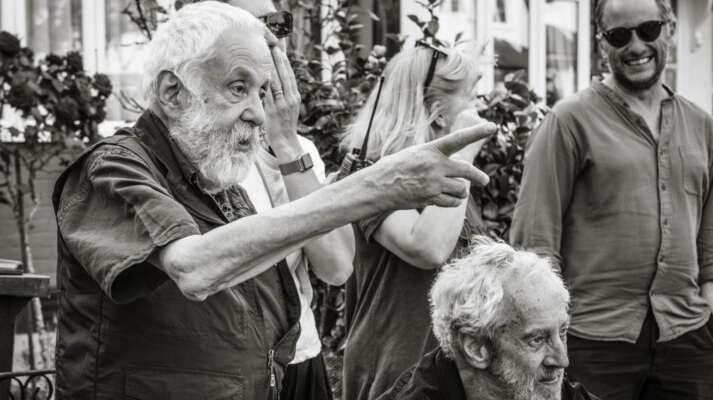Who's Who in Colette
The fascinating real people in Wash Westmoreland's Colette
Who's Who in Colette
Written by Peter Bowen
In casting the title character of Colette, director Wash Westmoreland immediately thought of Keira Knightley "She is one of the few people who can combine all the qualities needed to incarnate Colette," Westmoreland explains. "Keira is possessed of incredible intelligence and wit-which were ever-present in Colette's writing-and an innate understanding of portraying people of past times." Focusing in on the pivotal period of Colette's life when she moved from being a sparkling ingénue to becoming a self-possessed woman and artist, the film also brings to light the fascinating world of fin de siècle Paris. To highlight the real people who orbited about Colette during this period, we've put together a who's who, which provides the characters' backstories as well as an epilogue about what happened to them after the film ends.

Colette | Keira Knightley
In Wash Westmoreland's Colette, Keira Knightley plays the famous French artist during her formative early years. From her first marriage to Henry Gauthier-Villars, aka Willy (Dominic West)-who was fourteen years her senior-in 1893 to her divorce in 1910, the film captures how Colette bucked conventional mores to create her own identity as a woman and an artist. She found her artistic voice writing the immensely popular, semi-autobiographical Claudine novels at the turn of the century. Refusing bourgeoisie definitions of desire, she embraced a fluid sexuality, moving between her many husbands, including Willy, and her frequent lovers, such as Georgie Raoul-Duval (Eleanor Tomlinson) and Mathilde de Morny, known as Missy (Denise Gough).
The fiercely independent identity that she carved out at the turn of the century served her well during her 81 years of life. She wrote over 30 books, with some, like Cheri and Break of Day, considered to be classics of modern French literature. In addition to novels and short stories, she penned plays, movie treatments, film reviews, advice columns, travelogues, and first-hard reports. During World War I, she was one of the first women to report from the front lines of the conflict. Many of her works have been adapted into plays, musicals, television shows, and films. Her 1944 Gigibecame a hit Broadway play, before being transformed into a Hollywood musical, winning nine Academy Awards, including Best Picture. Living through three marriages, many affairs, and two World Wars, Colette remained a keen, and mostly hopeful, observer of human nature. In 1949, she published her final major work, Le Fanal bleu ( The Blue Lantern). When she died, the French government gave her a state funeral, the first such honor bestowed upon a woman writer. A few years before, the writer Katherine Anne Porter introduced her to an American audience in The New York Times, calling her "the greatest living French writer of fiction."

Henry Gauthier-Villars (aka Willy) | Dominic West
To portray Colette's first husband, Henry Gauthier-Villars (aka Willy), the filmmakers needed someone who could capture the man's complicated nature. "You want an actor who won't shy away from playing a character who's not a great guy," says producer Pamela Koffler. "But he also has to convey a lovability and an intellect. Dominic [West] could do all that and more."
Having given up the law-much to the dismay of his father-Willy found fame and fortune writing razor-sharp reviews of contemporary music. His brutal style angered as many artists as it drew new readers. After labeling Erik Satie's Les Fils des Étoiles "faucet salesman's music," Willy was nearly drawn into a deadly duel by the composer. As demand for his work outpaced his ability to create it, Willy employed ghostwriters to keep his various literary ventures flowing. In 1883, Willy, who was acquainted with Captain Jules Colette, first met his daughter, Sidonie-Gabrielle. Ten years later, the two married, and she would change her name to just Colette. Within a few years, Colette was also writing for Willy, creating in 1900 the novel Claudine at School, the first of four Claudine novels. The novels set off a craze in Paris, selling out their various editions, inspiring a successful play, and launching one of the first brand tie-ins with Claudine perfumes, chocolates, and the such.
While the two did not divorce until 1910, they had for all purposes separated by 1906. While Colette pursued a relationship with Missy, Willy took up with Marguerite Maniez, whom he met a decade before when she asked Willy to sign her copy of Claudine at School. In 1911, the two married, although it only lasted a few years. While Colette and Willy rarely met in later years, they often traded barbs in print. Willy continued to publish racy, ghostwritten works-26 of the fifty books credited to him were published after his split with Colette. But nothing brought him the fame or success of the Claudine novels. Burdened by debt and hindered by illness, he bemoaned his later fate, telling an old friend in 1927, "No one is interested in a seventy-year-old usherette," referring to his old pen name, "the Usherette of the Cirque d'Été." When he died in 1931, supposedly 3,000 people showed up for his funeral procession, although Colette appears not to have been one of them.

Mathilde de Morny (Missy) | Denise Gough
To capture the character of Mathilde de Morny (aka Missy), the filmmakers cast the up-and-coming actress Denise Gough, whose recent performance in the Broadway revival of Angels in America received a Tony nomination. For producer Koffler, Missy "became a quiet but powerful presence in Colette's life who showed her love, and Denise was able to get on that exact wavelength."
Born of a noble family (her father was the half brother of Napoleon III), Missy suffered an unhappy childhood of neglect and abuse. Married off at 18 by her family to the wealthy Jacques Godart, 6th Marquis de Belbeuf-whom many believe was gay himself-Missy had little interest in pretending to be the good wife. She separated from him after four years, officially divorcing him in 1903. Taking female lovers and wearing male clothing at a time when women dressing in trousers was a punishable offense, Missy became notorious in Paris circles. Missy and Colette met in 1905 and were soon enchanted with each other, summering together at the seaside town of Le Crotoy. On January 3, 1907, their relationship would make front-page news when an onstage kiss in their pantomime Rêve d'Égypte caused a near riot in the theater. In 1910, the year that Colette official divorced Willy, the pair bought Rozven, a small villa in coastal Brittany that Colette kept after they broke up two years later. Colette and Missy reconciled as friends in the 1920s with Missy often taking on a maternal role with the writer. As Missy's wealth shrunk over the years from lavish gifts and bad affairs, she often turned to Colette for help. In later years, she would house sit, taking care of Colette's pets when the writer was away on her many travels. Missy died on June 29, 1944, just weeks before the Allied troops' liberation of Paris.

Georgie Raoul-Duval | Eleanor Tomlinson
To play the socialite Georgie Raoul-Duval, the filmmakers cast Eleanor Tomlinson, who plays the wife of the title character of PBS's hit series Poldark.
Born Georgie Urquhart in Paris to a wealthy family from Louisiana, Georgie was educated in France. In 1891, she married René Raoul-Duval, the heir to a large industrial and mining fortune. With her house in Paris, and her husband often away on business, the glamorous and cultured Georgie became a fixture in the city's artistic salons. In 1901, when Claudine in Paris, the second Claudine book, came out, she began an affair with Colette. Perhaps at the same time, or a little later, she started to see Willy, although neither of her lovers was immediately aware of Georgie's arrangement. As an act of poetic justice, Willy and Colette thinly disguised their unexpected ménage-a-trois with Georgie in the 1902 Claudine Married. In the novel, Claudine has an affair with a Viennese woman named Rézi, who was an obvious stand-in for Georgie. Terrified by the potential scandal, Georgie unsuccessfully attempted to derail the publication. Later Georgie would strike out on a literary career of her own. In addition to penning several novels (in English), she wrote a play, The Golden Light, (under the name George Daring) that her sister, the socialite-turned-actress Cora Urquhart Brown-Potter, produced in 1905. Generally panned, the play closed after a few days. Georgie would die in 1913 at the young age of 47.
Caption: Charles Léandre's caricature of Pierre Veber

Pierre Veber | Ray Panthaki
The Asian-British actor Ray Panthaki plays the French playwright Pierre Veber. Born in 1869, Veber grew up in a famously artistic family. His brother was the painter Jean Veber, and Pierre was related through marriage to the scholar René Doumic and the playwright and novelist Tristan Bernard. Early in his career, Veber not only ghostwrote several stories for Willy's publications but also became close friends with the larger-than-life literary figure. In 1893, he stood up as a witness at Colette and Willy's wedding. Within two years, however, things soured between Veber and Willy. Having written the racy novel Une Passade (with both their names appearing on the cover), Veber demanded to be paid, creating a violent public scene. Even after the two reconciled, Veber's opinion of Willy's character was set. In 1898, when Willy refused to sign a petition in support of the falsely accused Jewish officer Alfred Dreyfus, Veber quipped, "It's the first time Willy has refused to sign something he didn't write." After his work with Willy, Veber went on to have a long, successful literary career, penning nearly one hundred, mostly comic works (including plays, essays, operettas, novels, and short stories). While his partnership with Willy proved less than desirable, Veber became renowned for his various collaborations on stage plays and novels alike. After Veber died in 1942, his descendants continued his literary legacy. His sons, Pierre-Gilles and Serge, became well-known writers, and his grandson Francis became a screenwriter and director, celebrated for such comedies as The Closet and Dinner for Schmucks.

Émilie Marie Bouchaud (aka Polaire) | Aiysha Hart
The British/Saudi actress Aiysha Hart plays Émilie Marie Bouchaud, the French/Algerian performer known as Polaire.
Born in Algiers in 1874 to a large, working class family, Émilie Marie Bouchaud moved with her mother to Paris in 1889. At 17, following in the footsteps of her brother, she began a career as a cabaret singer taking the stage name Polaire (the pole star). Within in a few years, she became an entertainment sensation with Toulouse-Lautrec painting her image for magazine covers. In 1902, she expanded her range when she took on the role of Claudine in the stage version of Colette's Claudine in Paris. While many other actresses would appear in the role, for Colette, "There was no other 'true Claudine' but Polaire." A master of self-presentation as well as performance, Polaire was famous for the striking public personas. For her cabaret act, she adopted a look of short hair long before it became all the rage. At a time when women strove to show off an hourglass silhouette, she was famous for her wasp-like 16" waist. When playing Claudine on stage, Polaire adapted the character's look off stage as well, sporting in public cropped dark hair, a black schoolgirl smock, a white collar, and a checked tie. Soon Colette, who had a similar shape to Polaire, imitated the same look. Willy, ever the promoter, would parade the two, creator and creation, around town for all to see and comment upon in gossip and print. In 1909, she began a new career as a film actress, appearing in various silent movies, including six directed by Maurice Tourneur. Unfortunately by the twenties, as cinema began to take off, she had grown too old for many filmmakers. She would later pursue a career as a recording artist, releasing her last record in 1936. She remained close friends with Colette until her death in 1939.

Madame De Caillavet (aka Léontine Lippmann) | Arabella Weir
Comedian and actress Arabella Weir plays Mme De Caillavet.
Born Léontine Lippmann in 1844 to a wealthy Jewish family, she took the name Madame Arman de Caillavet after marrying Albert Arman in 1868. The wealthy patron established herself early on as one of the most influential figures in Parisian cultural circles. By the time she met Colette in 1895, she was a 50-year-old grand dame of society. Her salon, frequented by the likes of the novelist Anatole France (who considered her his muse) and a young Marcel Proust, was one of most well respected. Proust later based his character Madame Verdurin in Remembrance of Things Past on her. Mme De Caillavet immediately took Colette under her wing, introducing her to other artists and writers and suggesting what new books she should read. At once generous and merciless, she'd once told her daughter-in-law, "You must take the world for what it is, despise it, and exploit it." In 1905, she broke off relations with Colette after hearing of scandalous comments made by Willy. She would continue to rule her corner of French literary society until her death in 1910.

Gaston De Caillavet | Jake Graf
To play the playwright Gaston De Caillavet, Westmoreland cast Jake Graf, an actor and spokesperson who has appeared in several short films detailing his life as a trans man.
The son of Albert Arman de Caillavet and Léontine Lippmann, Gaston grew up in a world of wealth and privilege, although the fact that his family's money came from a Jewish heritage was never lost on high society. In his twenties, the charismatic Gaston struck up a close friendship with Marcel Proust, who'd started attending Mme De Caillavet's literary salons. When Gaston proposed to Jeanne Pouquet, a captivating young woman who would later star in many of his stage productions, it was hard to tell with whom Proust was more infatuated. The two would serve as models for the characters of Robert de Saint-Loup and his wife Gilberte in Proust's Remembrance of Things Past. In 1894, Colette and Willy started a flirtatious friendship with Gaston and Jeanne that would end badly when Willy's suggestive comments about Jeanne caused an irreparable rift between the two households. At one point, Proust even acted as an intermediary, trying to make things better with Willy. By 1901, Gaston De Caillavet had begun a career-defining collaboration with playwright Robert de Flers, with the two producing over twenty-five wildly popular comedies and light operas. In 1915, at the age of 45, Gaston De Caillavet died from kidney failure after a long illness.
Caption: Otto Wegener's photo of Rachilde

Rachilde (Marguerite Vallette-Eymery) | Rebecca Root
To play the remarkable Rachilde, Westmoreland cast a trans woman, Rebecca Root, who has appeared in many films including The Danish Girl and the upcoming The Sisters Brothers.
Born in 1860, Marguerite Vallette-Eymery took to writing early on, partially to cope with the isolation she experienced growing up in the country to an indifferent family. At 15, she adopted the name Rachilde as her nom de plume. Encouraged by her literary idol Victor Hugo, Rachilde moved to Paris where she not only pursued a literary career but also completely remade her identity. Dressing as man, she launched a literary salon for other artists interested in pushing the envelope. Her 1884 debut novel Monsieur Venus proved so scandalous that Belgium condemned it as pornography, sentencing her to two-years in prison in absentia. In 1885, she married Alfred Vallette, who helped her begin her influential literary journal Mercure de France. While she would continue to write novels, poems, and polemics-twenty works in total-Rachilde became better known for her fierce support of controversial artists. In addition to hosting the likes of Oscar Wilde, the painter Paul Gauguin, the avant-garde playwright Alfred Jarry, and composer Maurice Ravel at her Tuesday salons-often presided over by her two rats, Kyrie and Eleison-she was an early support of Colette. As Colette grew more famous, however, Rachilde seemed to grow jealous of her friend. Colette's biographer Judith Thurman records how Rachilde snidely remarked, "It's a pretty [little ribbon]," after Colette was promoted to the Legion of Honor in 1920. At once freewheeling and anti-feminist, Rachilde lived to 93, shocking her neighbors until the very end.


